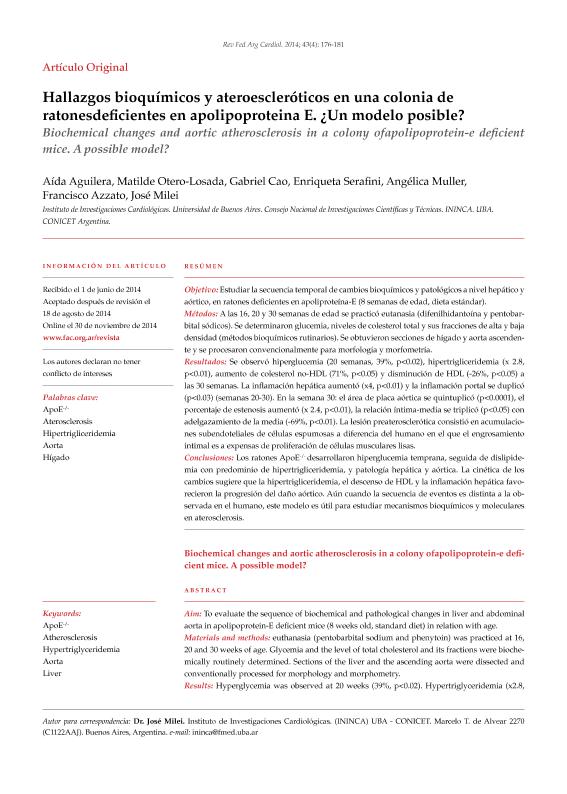Artículo
Hallazgos bioquímicos y ateroescleróticos en una colonia de ratones deficientes en apolipoproteina E: ¿Un modelo posible?
Título:
Biochemical Changes and Aortic Atherosclerosis in a Colony of Apolipoprotein-E Deficient Mice: A Possible Model?
Aguilera, Aída J.; Otero-losada, Matilde Estela ; Cao, Gabriel Fernando
; Cao, Gabriel Fernando ; Serafini, Enriqueta M.; Muller, Angelica del Carmen
; Serafini, Enriqueta M.; Muller, Angelica del Carmen ; Azzato, Francisco; Milei, Jose
; Azzato, Francisco; Milei, Jose
 ; Cao, Gabriel Fernando
; Cao, Gabriel Fernando ; Serafini, Enriqueta M.; Muller, Angelica del Carmen
; Serafini, Enriqueta M.; Muller, Angelica del Carmen ; Azzato, Francisco; Milei, Jose
; Azzato, Francisco; Milei, Jose
Fecha de publicación:
12/2014
Editorial:
Sociedad Argentina de Cardiología
Revista:
Revista de la Federación Argentina de Cardiología
ISSN:
1666-5694
Idioma:
Inglés
Tipo de recurso:
Artículo publicado
Clasificación temática:
Resumen
Aim. To evaluate the sequence of biochemical and pathological changes in liver and abdominal aorta in apolipoprotein-E deficient mice (8 weeks old, standard diet) in relation with age. Materials and methods: euthanasia (pentobarbital sodium and phenytoin) was practiced at 16, 20 and 30 weeks of age. Glycemia and the level of total cholesterol and its fractions were biochemically routinely determined. Sections of the liver and the ascending aorta were dissected and conventionally processed for morphology and morphometry. Results: hyperglycemia was observed at 20 weeks (39%, p<0.02). Hypertriglyceridemia (x2.8, p<0.01), an increase in non-HDL cholesterol (71%, p<0.05) and a decrease in HDL cholesterol (-26%, p<0.05) were found at 30 weeks. Liver inflammation and portal inflammation increased (4-fold, p<0.01 and 2-fold, p<0.03 respectively) between weeks 20-30. At week 30: aortic plaque area and the percentage of stenosis increased (respectively 5-fold, p<0.0001 and 2.4-fold, p<0.01) and the intima-media ratio increased (3-fold, p<0.05) with media thinning (-69 %, p<0.01). Preatherosclerotic lesions consisted of subendothelial clusters of foamy cells in contrast with intimal thickening due to smooth muscle cell proliferation as typically found in man. Conclusion: ApoE-/- mice spontaneously developed early hyperglycemia, followed by dyslipidemia with hypertriglyceridemia, and hepatic and aortic pathology. The sequence of the changes suggests that hypertriglyceridemia, decreased levels of HDL and hepatic inflammation favored aortic damage progression. Otherwise morphologically similar, the sequence of events resulting in plaque formation is different to that found in man. Bearing this in mind, the ApoE-/- mice model may be used to study the biochemical and molecular events underlying atherosclerosis.
Palabras clave:
Apo e Mice
,
Biochemical
,
Atherosclerosis
,
Aorta
,
Liver
,
Hypertriglyceridemia
Archivos asociados
Licencia
Identificadores
Colecciones
Articulos(ININCA)
Articulos de INST.DE INVEST.CARDIOLOGICAS (I)
Articulos de INST.DE INVEST.CARDIOLOGICAS (I)
Citación
Aguilera, Aída J.; Otero-losada, Matilde Estela; Cao, Gabriel Fernando; Serafini, Enriqueta M.; Muller, Angelica del Carmen; et al.; Hallazgos bioquímicos y ateroescleróticos en una colonia de ratones deficientes en apolipoproteina E: ¿Un modelo posible?; Sociedad Argentina de Cardiología; Revista de la Federación Argentina de Cardiología; 43; 4; 12-2014; 176-181
Compartir



